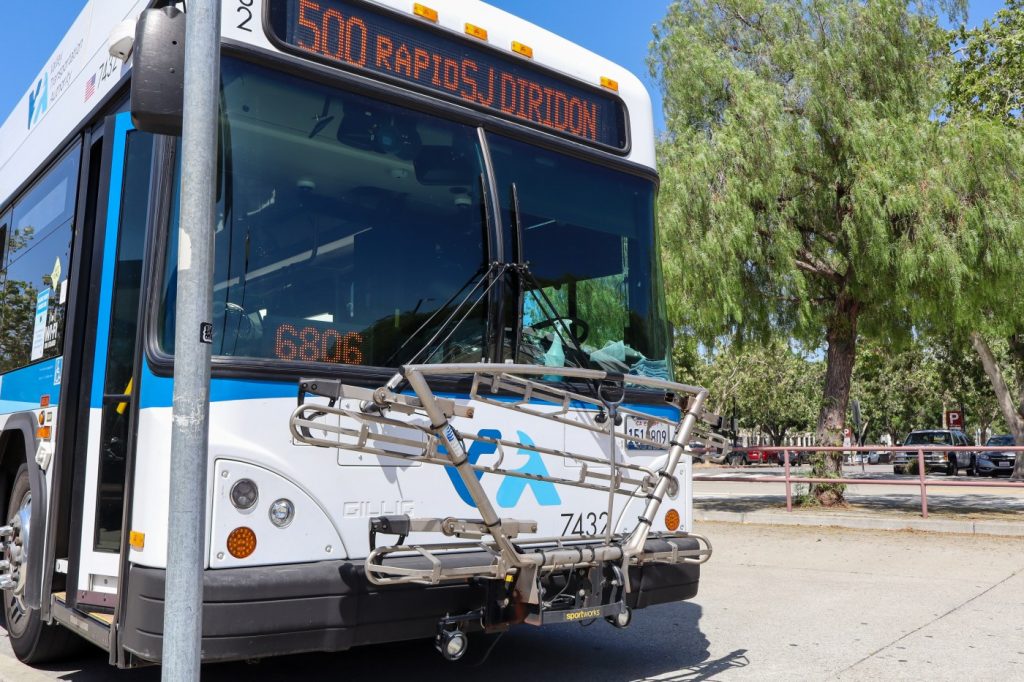Editor’s note: This story was produced for the independent Mosaic Journalism Program for Bay Area high school students, an intensive course in journalism. Students in the program report and photograph stories under the guidance of professional journalists.
On a recent day, early morning passengers of the Valley Transportation Authority (VTA)’s 64B bus waited for it to arrive at 7a.m., but it didn’t show up. Waiting for the next bus scheduled at 7:30 a.m., they found no bus showed up. By the time a bus did arrive, many passengers were late for work or school.
“I take the 8 a.m. 64B bus twice every day to commute to school, as it’s the only one I can rely on,” San Jose State University student Saumi Saurin Shah said. “I’m always a little late to my 9 a.m. class, and last semester, I would miss 15 to 20 minutes every morning. I would prefer to take the 7:30 a.m. line because my classes start at 9 a.m., but it is canceled too often.”
These bus cancellations are not attributed to chance, but rather, representative of a larger issue plaguing VTA: maintenance backlogs leading to bus shortages, according to bus drivers and union officials.
The VTA’s 500 Rapid bus waits for riders at Diridon Station in San Jose on June 6, 2024. (Areha Shah/Mosaic)
According to VTA, bus cancellations occur due to either a lack of bus operators or maintenance issues—and primarily the latter. In fact, in 2023, 78% of bus cancellations were due to “buses needing preventative and running repair maintenance,” VTA said. The transit agency could not provide the exact number of bus cancellations.
Created in 1972, VTA provides public transportation — including bus, light rail and heavy rail — across Santa Clara County. The bus system specifically boasts an average ridership of 75,000 each weekday, with over 3,200 bus stops across 48 bus lines, according to VTA. There are over 520 buses in the fleet, each costing between $600,000 to $1 million.
Related Articles
East Palo Alto program feeds region’s hungry residents
San Jose’s textiles museum nears fundraising goal
San Jose performance connects teens to legends of their parents
Google’s huge San Jose project moving ahead
New San Jose cafe combines coffee and kitties waiting for adoption
“This issue is actually very deep-rooted. Over the years, we’ve had several different bus models get procured, and it is typical for VTA to run the fleet they currently have past its recommended run time,” Raj Singh, president and business agent of Amalgamated Transit Union (ATU) 265, said. “This is a cost-effective measure, but once the buses are past their recommended usage time, significant repairs need to be made.” Part of the nationwide ATU union, ATU 265 is the largest union representing VTA workers — including bus operators, mechanics and municipal employees.
Tools and parts shortages as well as a lack of proper infrastructure hinder these repairs to create a maintenance backlog, said Zac Bodle, assistant business agent of maintenance for ATU 265. For example, either basic parts such as light bulbs and nuts and bolts are lacking inventory stock, or mechanics do not have the tools they require to repair these parts. In one instance, Bodle recounted how mechanics needed to fix components on top of hybrid buses’ roofs. However, these repairs were delayed by months, Bodle said, because VTA did not own the proper harnesses needed to go onto the roof to fix these buses.
Recently, bus lines like 64A and 64B have also been subject to cancellations as buses scheduled for those lines are used as bus bridges, or replacements for shut-down VTA light rail segments during the current rail rehabilitation project.
“There’s no accountability on VTA’s part, whereas it is bus mechanics’ job to get each bus up and make sure it is safe to go down the road. Safety is our No. 1 priority as a union, but VTA is not buying the parts that we need to make repairs a safe process,” Bodle said.
When asked about the issue, VTA said that they are looking into solutions, and maintained that buses are always kept in “safe operating conditions” if they must be used past their recommended replacement cycles.
Riders bear the brunt of the VTA maintenance problems.
“I take VTA buses every day and my buses have been canceled way too many times. I’ve also seen buses without functioning screens, outside signs, or air conditioning and heating,” Makoto Abe, Bellarmine College Preparatory student, said. Abe wakes up at 6:20 a.m. every morning to take an early bus in order to account for any cancellations, and thinks that VTA “definitely needs more buses and more routes.”
Although VTA did not mention plans to expand the existing bus system, they stated that they are working on a plan to make the maintenance process more efficient — including hiring an outside consultant to oversee parts availability and developing new technological solutions for parts inventory. Yet unions hope that more urgent change can be made.
“We are trying to work with VTA to resolve this issue, but it seems to be like a hamster wheel. We just keep going over the same problems over and over again,” Bodle said.
Antara Gangwal is a member of the class of 2025 at Leland High School in San Jose.


